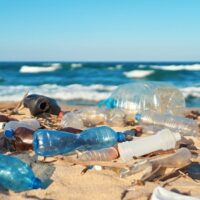What Oceanic and Atmospheric Research Does
Deep beneath the waters of the Pacific just off Hawaii hides a mysterious world — one that has never been explored before — until now. Enter NOAA’s Okeanos Explorer, an exploration vessel, where experts are using remotely operated vehicles to explore these never-before-surveyed waters. The dives have revealed surprising discoveries, like previously unknown marine life, shipwrecks with random Ford trucks, and even monoliths nearly 50 feet tall! Discoveries like this are revealed because of the programs that make up the Oceanic and Atmospheric Research (OAR) branch of NOAA, aka “NOAA Research.”
Each division has a distinct job that contributes to the branch mission and each division is as important as the next. Losing one or any part of NOAA Research would be like going blindfolded into a future where we have more extreme weather, rising seas, and disappearing species putting lives, economies, and ecosystems at risk. Below we break down each division…
WHAT OCEANIC AND ATMOSPHERIC RESEARCH DOES AND WHY WE SHOULD CARE
RESEARCH LABS
NOAA research labs perform a lot of the behind-the-scenes science that helps us understand and protect our planet. With a variety of labs around the country, researchers study everything from weather patterns and climate change to ocean health and air quality.
The work done at NOAA research labs doesn’t just sit on a shelf — it’s used in all kinds of practical, real-world ways. Scientists at NOAA take what they discover and turn it into tools, models, and data that help everyone from emergency responders to fishers to even airlines. For example, a recent study analyzed turbulence during flights to improve safety and comfort for those who fly.
What makes NOAA research labs really unique is that most of their data is public so it can benefit everyone! That includes businesses, scientists, policymakers, educators, and the public.
CLIMATE PROGRAM OFFICE
The NOAA Climate Program Office is the key hub for all researchers who study Earth’s climate. Climate being long-term patterns of weather, like hot or cold and rain or snow. They also help organize and support scientists who ask big questions like: or “How will weather be different in the future? And what can we do to better prepare and adapt for it?”
They collect clues from the air, oceans, and even ice to figure out what’s changing and why. Then, they share that information with leaders, teachers, and communities so we can all make smart choices – like how to protect homes from floods or grow crops when it’s hotter than usual. Even something as simple as trying to plan a vacation around predicted hotter months…all that information comes from this office.
GLOBAL OCEAN MONITORING AND OBSERVING PROGRAM (GOMO)
Global Ocean Monitoring and Observing provides and supports global ocean data over long periods of time. They use large-scale observing systems to monitor salinity, temperatures, currents, and carbon levels in water. All these factors translate information regarding our changing climate. Without a full picture of these elements, we cannot understand or react to our climate and changes in our weather systems.
NATIONAL SEA GRANT COLLEGE PROGRAM
The Sea Grant Program is a partnership between NOAA and universities established back in the 1960’s. The program combines more than 3,000 scientists, engineers, public outreach experts, educators, and students to help citizens better understand, conserve, and use America’s coastal resources. In 2023 alone, the results from the Sea Grant Program resulted in an almost $830 million economic benefit. And it leverages nearly $3 for every $1 appropriated by Congress and invests those funds directly in support of local needs.
WEATHER PROGRAM OFFICE
The Weather Program Office funds research to improve weather forecasting. The team works closely with the National Weather Service to help everyone better understand tropical cyclones, severe storms, extreme precipitation, and air pollution. Without this funding, the National Weather Service would have a tough time providing accurate and timely weather forecasts that ultimately impact safety and disaster preparedness.
OCEAN EXPLORATION
NOAA Ocean Exploration is like the Indiana Jones of federal agencies. This team is entirely dedicated to exploring the parts of the ocean that have never been explored. This is massively important because to this day, most of our oceans remain unexplored. The current focus is on the deep-sea where researchers hope to identify potential resources like energy and minerals, and even discover new sources for medicines and vaccines.
Oceana has used the results of these expeditions to identify vulnerable deep-sea areas and has helped secure protections for deep-sea coral and sponge areas in the Atlantic and Pacific, based in part on NOAA discoveries.
Do yourself a favor and check out the livestreams of a current research project here to get a full understanding of their work – you won’t be disappointed.
OCEAN ACIDIFICATION PROGRAM (OAP)
The Ocean Acidification Program looks at how the chemistry in our oceans is changing, what sort of impacts that can have on marine life and people, and how we can adapt. Scientists have found the ocean is becoming more acidic as its water absorbs carbon dioxide from the atmosphere. This reduces the amount of carbonate — a key building block — in the ocean and creates weaker shells in shellfish like oysters and corals, die-offs of scallops and oyster larvae, and even changes in fish behavior. Every year in the U.S., oysters, clams, and scallops bring in about $400 million. But if we don’t address ocean acidification, shrinking shellfish supplies could end up costing consumers around $480 million a year by the end of the century.
OFFICE OF RESEARCH, TRANSITION, AND APPLICATION (ORTA)
The Office of Research, Transition, and Application handles research and development for NOAA. ORTA helps move research findings from the lab to operational use, commercialization, or other practical applications including work to help respond to ocean acidification by giving communities tools that measure pH levels. This allows shellfish farmers and coastal managers to plan accordingly and reduce losses.
The technology that comes from this office helps to improve the U.S. economy, society, and the environment.
OFFICE OF SCIENCE SUPPORT
The Office of Science Support is like the project manager of NOAA research. The team ensures NOAA’s scientific endeavors have the necessary resources, infrastructure, and support to succeed. They also coordinate with universities, research and development, and public outreach.
HOW YOU CAN GET INVOLVED
Oceana campaigns to protect our oceans, and that means protecting NOAA. Right now, the agency is facing threats, but your voice can help. Take action today to call on your members of Congress to save NOAA and its programs that are critical to our oceans, coastal communities, and economy.
This is the second installment of our ‘What Does NOAA Do‘ series. Check out the next installment to learn more about what the National Ocean Service does.
MOST RECENT
August 29, 2025
August 22, 2025
Corals, Community, and Celebration: Oceana Goes to Salmonfest!



